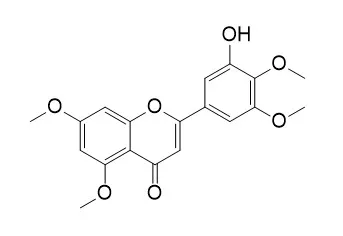| Structure Identification: |
| J Agric Food Chem . 2021 Apr 7;69(13):3879-3886. | | Biotransformation of 5,7-Methoxyflavones by Selected Entomopathogenic Filamentous Fungi[Pubmed: 33780240] | | 5,7-Dimethoxyflavone, a chrysin derivative, occurs in many plants and shows very low toxicity, even at high doses. On the basis of this phenomenon, we biotransformed a series of methoxy-derivatives of chrysin, apigenin, and tricetin obtained by chemical synthesis. We used entomopathogenic fungal strains with the confirmed ability of simultaneous hydroxylation/demethylation and glycosylation of flavonoid compounds. Both the amount and the place of attachment of the methoxy group influenced the biotransformation rate and the product's amount nascent. Based on product and semi-product structures, it can be concluded that they are the result of cascading transformations. Only in the case of 5,7,3',4',5'-pentamethoxyflavone, the strains were able to attach a sugar molecule in place of the methoxy substituent to give 3'-O-β-d-(4″-O-methylglucopyranosyl)-5,7,4',5'-tetramethoxyflavone. However, we observed the tested strains' ability to selectively demethylate/hydroxylate the carbon C-3' and C-4' of ring B of the substrates used. The structures of four hydroxyl-derivatives were determined: 4'-hydroxy-5,7-dimethoxyflavone, 3'-hydroxy-5,7-dimethoxyflavone, 3'-Hydroxy-5,7,4',5'-Tetramethoxyflavone, and 5,7-dimethoxy-3',4'-dihydroxyflavone (5,7-dimethoxy-luteolin). |
|






 Cell. 2018 Jan 11;172(1-2):249-261.e12. doi: 10.1016/j.cell.2017.12.019.IF=36.216(2019)
Cell. 2018 Jan 11;172(1-2):249-261.e12. doi: 10.1016/j.cell.2017.12.019.IF=36.216(2019) Cell Metab. 2020 Mar 3;31(3):534-548.e5. doi: 10.1016/j.cmet.2020.01.002.IF=22.415(2019)
Cell Metab. 2020 Mar 3;31(3):534-548.e5. doi: 10.1016/j.cmet.2020.01.002.IF=22.415(2019) Mol Cell. 2017 Nov 16;68(4):673-685.e6. doi: 10.1016/j.molcel.2017.10.022.IF=14.548(2019)
Mol Cell. 2017 Nov 16;68(4):673-685.e6. doi: 10.1016/j.molcel.2017.10.022.IF=14.548(2019)